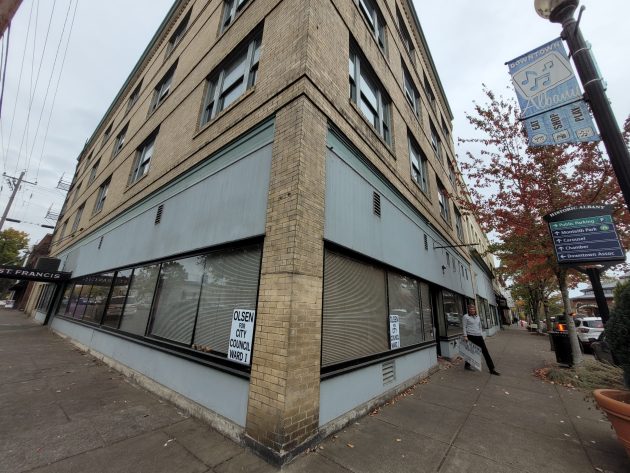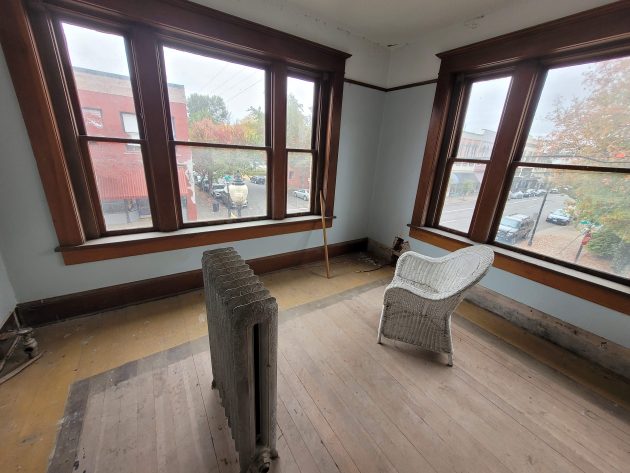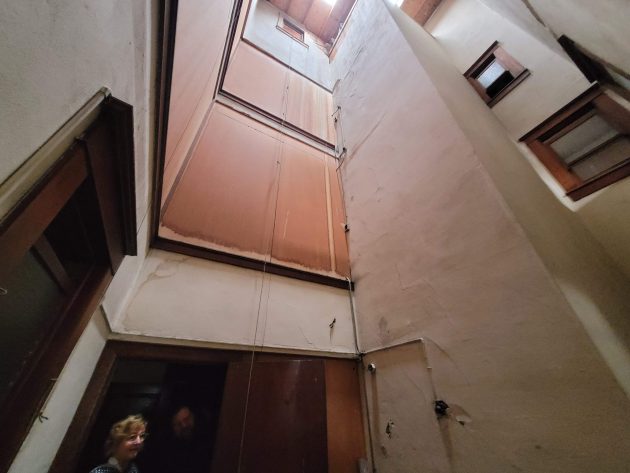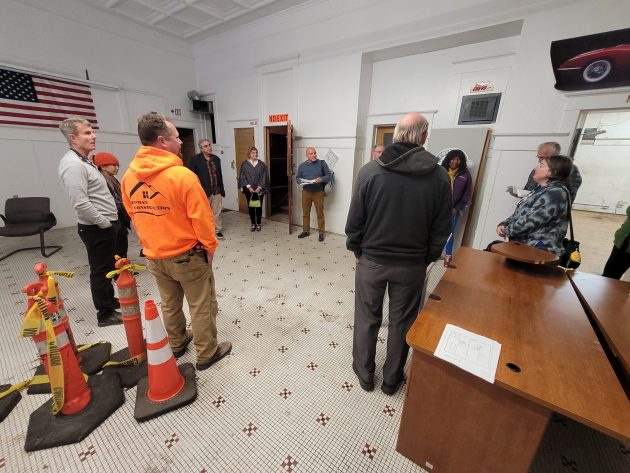
Scott Lepman steps from the St. Francis after Friday’s tour with the State Advisory Committee on Historic Preservation.
Scott Lepman doesn’t have an estimate of how long it will take to refurbish the old St. Francis Hotel at Ferry Street and First Avenue in downtown Albany. But he, his brother Spencer and their construction crew are about to start.
They’ve already removed asbestos from the 107-year-old building. Next, they’ll start demolishing enough of the inside walls to get a look at where and how to install new wiring and plumbing and such.
All this demo work is planned to start in a few weeks, after the crew completes the last details on the Opera House apartments at 222 S.E. First, on which the Lepmans have been working since about 2016.
One of the Lepman companies, Sable Drive LLC, bought the St. Francis building in a transaction helped along by the Albany Revitalization Agency. The plan is to retore the four-story building for commercial use on the ground floor and residences on the upper stories.
On Friday, members of the State Advisory Committee on Historic Preservation walked through the vacant rooms on the ground floor, for 60 years or so the home of Pride Printing Co., and climbed up a dark staircase to inspect some of the long abandoned hotel rooms on the second floor.
The state committee was in the area because it was to meet in Corvallis for one of its regular sessions. Among the agenda items: Nominating the Riverside Community Hall in Linn County for a listing in the National Register of Historic Places.
For the St. Francis, the Lepman group has prepared a detailed preservation plan.
Among countless other details, the plan is to reinforce the building so it won’t collapse in an earthquake. Other items include refinishing the wooden floors and restoring or repairing all the single-pane windows and their wood frames and sashes.
Lepman told me that during construction they’ll set up the ground floor as a work space for repairing the other parts of the building, including the windows.
The preservation plan shows boxes to be checked for progress reports after three, six, and nine years. This will take a while, in other words, so don’t expect this job to be finished soon. (hh)

The view Friday from the corner room on the second floor of the St. Francis.

Checking out the three-story light well on the interior of the former hotel.

Scott Lepman, left, and others on his team greet the historic preservation panel before Friday’s tour.

Go Scott, go.
The Lepman’s have done a LOT to revitalize buildings in Albany. Keep doing what you’re doing. Make money at it, it’s the American way. Restore what could be lost. That’s the community way.
I would have no problem with your comment if Lepman made all of his money the old fashioned way – he earned all it.
But Lepman relies on CARA providing a significant amount of unearned income. This is money that comes from the other taxing districts and ultimately from the taxpayers without their approval.
Want to make a positive change?
Convince Salem lawmakers, or use direct democracy, to change the law to allow the other taxing districts (for example: Linn County, GAPS, LBCC) to opt out of being forced to give money to CARA or any future CARA that the city wants to create.
Here is how much CARA will forcibly take (“Total Amount Imposed”) from the other taxing districts in Tax Year 2022-2023:
https://www.co.linn.or.us/sites/default/files/fileattachments/assessment_amp_taxation/page/3630/sal4e.pdf
Linn County $422k
ESD $81k
LBCC $133k
GAPS $1.2M
4H $23K
City $1.7M
This is property tax revenue that is being taken by CARA to pay their bond debts. This money is taken without approval or a vote (note the “Imposed” verbiage the assessor used).
If taxpayers want to give up some government services provided by the taxing districts to pay CARA’s debts, then formal approval via state law or the ballot should happen. A simple majority on the city council should not have this power.
I am so excited that the Lepmans took on this project!
Where are the usual grumpy old trolls on this thread?
Out paying their taxes
Is that supposed to insinuate that I don’t? Barking up the wrong tree ex-Councilor
BRAVO! The corner room with those huge windows and eye on Downtown is classic!
Many recent articles point to the ineffectiveness of Oregon’s education system, what with some of the nation’s lowest graduation rates and some of the nations poorest Standardized Testing scores. Albany/GAPS students have not escaped this lousy performance review.
To that end, it seems more than a little odd that Albany’s citizenry allows ANY tax dollars from the GAPS budget to be siphoned-off in order to build an alleged Boutique Hotel in the downtown core. These vanity projects are all well and good for the builder and for the hotel guests who can afford the undoubtedly expensive room rates the trendy hotel will indubitably charge, but that seems a poor trade-off against the future of our community.
Parents of these under-performing students should ask themselves a question: Does Albany do better if its citizens can read, write, add and subtract, or is it wiser to pander to business developers and the monied class who can afford to spend the night at some hostel?
I realize that the $1.2-million annual contribution to CARA from GAPS coffers will not solve the performance problems of our schools entirely, but doesn’t it make better sense to spend that money on the kids in the hopes that it just might add enough educational value to the GAPS system so that a few more students will graduate and grow up to be thoughtful, contributing citizens? Doesn’t seem like a difficult choice.
I’ll suggest the recent $159 million GAPS bond the voter’s approved, amply covers your concern..
What you’re suggesting is that Taking With One Hand (GAPS BOND) is the justification for Giving With The Other (CARA “donations”). But, had there not been a GAPS Bond, there was still a CARA-contribution in place. And, had there not been a GAPS-to-CARA-contribution of $1.2 million, then students would have benefited from those dollars, as would all citizens of Albany. Instead, the $1.2-million is siphoned-off and granted to construction companies who build infrastructure, Structure that largely benefits the builder and the few who stay in the shiny new object downtown. This suggests that the GAPS Bond “ask” could have been reduced by $1.2-million and the taxpayers would have benefited. If you multiply the annual $1.2-million contribution over the life of the GAPS Bond…well that ain’t no chump change.
Please do not tell me that the new shiny hotel downtown is going to benefit us all. That sounds an awful lot like Trickle Down economy stuff…a failed economic policy that never really seems to trickle down.
I definitely disagree with the tortured logic you and Gordon espouse. Thankfully, we have what we have and Albany hugely better off for it.
Because of how the State of Oregon funds K-12 Districts and Educational Service Districts, local Urban Renewal Districts do not result in less funds for schools.
Measures 5/50 (approved by voters in the ‘90s) significantly changed how schools are funded.
School Districts receive funding from the State School Fund on a per pupil basis. There is a state-wide equalization formula that ensures all schools receive equal amounts of funding for students. The Legislature basically “back-fills” the loss of local property tax revenues with other funding.
The important number for Schools is how much the Legislature/Governor decide the State School fund will be.
There are around 100 URDs throughout the State. If they took away from schools, that would be a strong argument against them.
CARA, like every URD that imposes Tax Increment Financing, is a ZERO-SUM GAME.
Like you said, revenues lost means the State School Fund must be “back-filled” to compensate for the loss.
How MUCH was “back-filled” from somewhere else? I’ve read that it is $100-$120 million just for FY 2020-2021.
And who was this money taken from? Does anybody know?
The impact of URDs on taxing entities, including schools, is a significant expense.
CARA apologists can’t conceal this unpleasant funding truth by saying, in effect, “Nothing to see here. Please move along…”
I have a difficult time believing education advocates in Salem are leaving hundreds of millions (maybe billions under all URDs) on the table every year in the service of urban renewal.
https://www.oregon.gov/dor/programs/gov-research/Documents/Property-tax-report-2020-21.pdf
page number 56, Table 3.2 District Totals
This report identifies the property tax revenues that URDs statewide took from the taxing districts (County, City, Education, Other).
Education
FY 2019-2010 = $116,312,266
FY 2020-2021 = $118,987,809
Note: “Education” includes K-12, Community Colleges, and ESD’s. But most of the amounts come from K-12 as evidenced by the Linn County Assessors report on CARA.
If “Education” is being “back-filled” from somewhere else, then who? Please be specific so people can make their own judgement on the trade-off decisions state government is evidently making.
The Legislature/Governor when they agree on the total amount for the State School Fund.
Gordon has a massive chip on his shoulder for Albany.
It’s evident since he lives in North Carolina, and chooses to tell everybody how everything is wrong if you don’t live like he wants to live.
I’m glad to see the Lepmans taking on projects like this. I love the second story photo you share here and commend the Lepmans for their attempts to preserve some of this history. If Cara funds help make this possible, it is no fault of the contractor for utilizing what is available to them. I agree that there could be rule or legislative changes concerning the establishment and use of systems like Cara, but regardless it is good to see this project proceeding.
Thank you Scott lepman for getting cara to issue funds to you for taking on this project, better than the project that was purposed years ago, and the bonus is it cuts into the ridiculous water front funds, but wait the architect was paid $ 3 million for some water color prints to a project that doesn’t do anything to the river to make it navigateable , stunning amount of money to make a 5’ wider sidewalk, go for Scott money we’ll spent